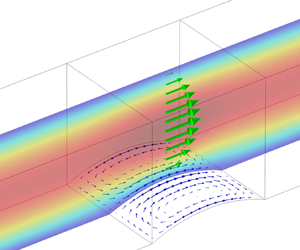Crossref Citations
This article has been cited by the following publications. This list is generated based on data provided by
Crossref.
Li, Hongyuan
Ji, SongSong
Tan, Xiangkui
Li, Zexiang
Xiang, Yaolei
Lv, Pengyu
and
Duan, Huiling
2020.
Effect of Reynolds number on drag reduction in turbulent boundary layer flow over liquid–gas interface.
Physics of Fluids,
Vol. 32,
Issue. 12,
Li, Zexiang
Dang, Xiangxin
Lv, Pengyu
and
Duan, Huiling
2021.
Blowing-only opposition control: Characteristics of turbulent drag reduction and implementation by deep learning.
AIP Advances,
Vol. 11,
Issue. 3,
Gaddam, Anvesh
Sharma, Himani
Ahuja, Ratan
Dimov, Stefan
Joshi, Suhas
and
Agrawal, Amit
2021.
Hydrodynamic drag reduction of shear-thinning liquids in superhydrophobic textured microchannels.
Microfluidics and Nanofluidics,
Vol. 25,
Issue. 9,
Lu, Haowei
Huang, Feng
Jiang, Peixue
and
Xu, Ruina
2021.
Exsolution effects in CO2 huff-n-puff enhanced oil recovery: Water-Oil-CO2 three phase flow visualization and measurements by micro-PIV in micromodel.
International Journal of Greenhouse Gas Control,
Vol. 111,
Issue. ,
p.
103445.
Park, Hyungmin
Choi, Chang-Hwan
and
Kim, Chang-Jin
2021.
Superhydrophobic drag reduction in turbulent flows: a critical review.
Experiments in Fluids,
Vol. 62,
Issue. 11,
Li, Chunxi
Xiao, Han
Jiang, Rui
and
Ye, Xuemin
2021.
Effect of wall slip on vertical film drainage in presence of soluble surfactants.
Physics of Fluids,
Vol. 33,
Issue. 4,
Smyrnakis, Athanasios
Ioannou, Dimosthenis
Ellinas, Kosmas
Tserepi, Angeliki
and
Gogolides, Evangelos
2022.
Real‐Time Monitoring and Quantification of Underwater Superhydrophobicity.
Advanced Materials Interfaces,
Vol. 9,
Issue. 4,
Li, Hongyuan
Cao, Yufan
Wang, Xiangyu
Wan, Xia
Xiang, Yaolei
Yuan, Huijing
Lv, Pengyu
and
Duan, Huiling
2022.
Accurate PIV measurement on slip boundary using single-pixel algorithm.
Measurement Science and Technology,
Vol. 33,
Issue. 5,
p.
055302.
Du, Zengzhi
Li, Hongyuan
Cao, Yufan
Wan, Xia
Xiang, Yaolei
Lv, Pengyu
and
Duan, Huiling
2022.
Control of flow separation using biomimetic shark scales with fixed tilt angles.
Experiments in Fluids,
Vol. 63,
Issue. 10,
Mizev, Aleksey
Shmyrov, Andrey
and
Shmyrova, Anastasia
2022.
On the shear-driven surfactant layer instability.
Journal of Fluid Mechanics,
Vol. 939,
Issue. ,
Baier, Tobias
and
Hardt, Steffen
2022.
Shear flow over a surface containing a groove covered by an incompressible surfactant phase.
Journal of Fluid Mechanics,
Vol. 949,
Issue. ,
Davey, Shaun
Atkinson, Callum
and
Soria, Julio
2023.
Measuring unsteady drag of the flow around a sphere based on time series displacement measurements using physics-informed neural networks.
Experimental Thermal and Fluid Science,
Vol. 144,
Issue. ,
p.
110824.
Yin, Zuozhu
Li, Min
Li, Zihao
Deng, Yuanting
Xue, Mingshan
Chen, Yuhua
Ou, Junfei
Lei, Sheng
Luo, Yidan
and
Xie, Chan
2023.
A harsh environment resistant robust Co(OH)2@stearic acid nanocellulose-based membrane for oil-water separation and wastewater purification.
Journal of Environmental Management,
Vol. 342,
Issue. ,
p.
118127.
Ji, Songsong
Li, Hongyuan
Du, Zengzhi
Lv, Pengyu
and
Duan, Huiling
2023.
Influence of interfacial coupled flow on slip boundary over a microstructured surface.
Physical Review Fluids,
Vol. 8,
Issue. 5,
Deng, Yuanting
Xu, Fanglin
Yin, Zuozhu
Xue, Mingshan
Chen, Yuhua
He, Peng
Wu, Jisi
Ou, Junfei
Wang, Fajun
Luo, Yidan
and
Hong, Zhen
2023.
Controllable fabrication of superhydrophobic alloys surface on 304 stainless steel substrate for anti-icing performance.
Ceramics International,
Vol. 49,
Issue. 15,
p.
25135.
Chen, Xiaoxiang
Yin, Zuozhu
Yan, Jiale
Xue, Mingshan
Chen, Yuhua
Yang, Chenggang
and
Luo, Yidan
2023.
Fabrication of ZnO@Fe2O3 superhydrophobic coatings with high thermal conductivity.
Surface and Coatings Technology,
Vol. 467,
Issue. ,
p.
129701.
Baier, Tobias
2023.
Influence of incompressible surfactant on drag in flow along an array of gas-filled grooves.
Physical Review Fluids,
Vol. 8,
Issue. 4,
Temprano-Coleto, Fernando
Smith, Scott M.
Peaudecerf, François J.
Landel, Julien R.
Gibou, Frédéric
and
Luzzatto-Fegiz, Paolo
2023.
A single parameter can predict surfactant impairment of superhydrophobic drag reduction.
Proceedings of the National Academy of Sciences,
Vol. 120,
Issue. 3,
Li, Min
Liu, Weiqing
Yin, Zuozhu
Yang, Haitao
Chen, Yuhua
Yang, Chenggang
Luo, Yidan
Hong, Zhen
Xie, Chan
and
Xue, Mingshan
2023.
Facile fabrication of superhydrophobic and photocatalytic self-cleaning flexible strain sensor membrane for human motion.
Sensors and Actuators A: Physical,
Vol. 363,
Issue. ,
p.
114750.
Zhong, Yuxue
Du, Yan
Qiu, Rundi
Xiao, Zhijian
Huang, Jian
Wang, Zhiying
Wang, Jingzhu
and
Wang, Yiwei
2023.
Seal types of water-entry cavities generated by the impact of spheres with decreasing Bond number.
Acta Mechanica Sinica,
Vol. 39,
Issue. 6,





